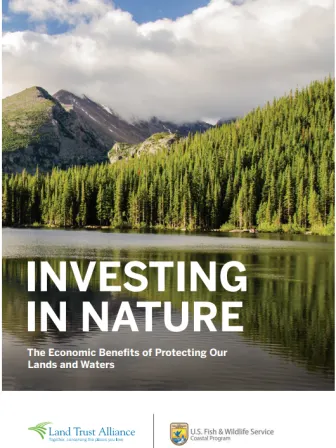Investing In Nature: The Economic Benefits of Protecting Our Lands and Waters
Source

About This Publication
We all benefit from nature.
From the pure pleasure of experiencing it, to the food and water it provides us, the value of nature is in one sense priceless.
But nature’s economic worth can also be quantified. Research shows that land conservation adds an impressive economic value by boosting local economies through tourism and jobs, saving money on health care, filtering drinking water, providing natural disaster mitigation, and more.
The Land Trust Alliance and U.S. Fish and Wildlife Service – Coastal Program have created a brochure that offers a snapshot of nature’s many economic benefits.
Did you know?
24+ Million
saved annual in residents' medical costs thanks to the urban trail system in Jefferson County, Alabama.1
$7 billion
saved in water treatment infrastructure costs in New York City from drawing drinking water from protected watersheds.2
1,900 jobs
supported by sport fishing in the Matanuska-Susitna Borough of Alaska.3
Sources for Brochure Statistics
Sources for the Statistics Referenced in the Brochure: “Investing In Nature: The Economic Benefits of Protecting Our Lands and Waters”
Rhe urban trail system in Jefferson County, Alabama, will save residents $21 million–$43 million in medical costs annually.
Source: Sen, B. 2010. Survey: Assessing the Impact of Green Spaces on Physical Activity (PA) & Healthcare Costs in Jefferson County, AL. University of Alabama School of Public Health.
[Note: The amount of $42 million is also featured in accredited Freshwater Land Trust (AL) publications]
New York City saves about $7 billion in water treatment infrastructure costs by drawing its drinking water from protected watersheds.
Source: Elliman, K. and Berry, N. (2007) Protecting And Restoring Natural Capital In New York City's Watersheds To Safeguard Water, in Aronson, J.; Milton, S.J.; Blignaut, J.N. (eds.). Restoring Natural Capital: Science, Business and Practice. Island Press, Washington D.C.: 208-215.
Spending on sport fishing supports as many as 1,900 jobs and generates as much as $64 million in income for workers in the Mat-Su Borough.
Source: Colt, S. and Schwoerer, T. (2009). Economic Importance of Sportfishing in the Matanuska-Susitna Borough. Retrieved from Institute of Social and Economic Research, University of Alaska Anchorage
A similar type of dam removed in Taunton, MA, saved an estimated $1.5 million in emergency response costs caused by flooding.
Source: Industrial Economics, Incorporated. (2015). Community Benefits of Stream Barrier Removal Projects in Massachusetts: Costs and Benefits at Six Sites. Retrieved from Massachusetts Department of Fish and Game Division of Ecological Restoration
Coral reef ecosystems in Hawai'i generate an estimated $360 million a year for the local economy, which includes recreation and fisheries.
Source: Cesar, H., P. van Beukering, S. Pintz, and J.Dierking, 2002. Economic valuation of Coral Reefs of Hawai’i. Hawai’I Coral Reef Initiative, University of Hawai’I, Honolulu.
People who engage in moderate exercise outdoors can save an average of $1,100 in medical costs annually.
Source: The Trust for Public Land. (2016). The Economic Benefits of the Park & Recreation System in San José, California. Retrieved from The Trust for Public Land
In the city, trees can make you feel 7 years younger and $10,000 richer.
Source: Neighborhood greenspace and health in a large urban center. Omid Kardan, Peter Gozdyra, Bratislav Misic, Faisal Moola, Lyle J. Palmer, Tomáš Paus & Marc G. Berman. Nature Scientific Reports 5, Article number: 11610 (2015) doi:10.1038/srep11610. 09 July 2015
Treating drinking water from an unprotected watershed can cost 10 times more than treating water from a protected watershed.
Source: Trust for Public Lands. 2010. The Economic Benefits and Fiscal Impact of Parks and Open Space in Nassau and Suffolk Counties, New York.
Trees can provide urban communities over $3.6 million in stormwater benefits annually.
Source: United States Environmental Protection Agency - Office of Wetlands, Oceans and Watersheds. 2013. Stormwater to Street Trees: Engineering Urban Forests for Stormwater Management, Washington, DC. [Note: Stormwater benefits were adjusted to 2016 dollars.]
Proximity to protected lands, like National Wildlife Refuges, can increase urban home values by 3-9%.
Source: L. Taylor et al. 2012. Amenity Values of Proximity to National Wildlife Refuges.
Nationally, bird watching supports more than 660,000 jobs and $31 billion in employment income.
Source: E. Carver. 2013. Birding in the United States: A Demographic and Economic Analysis. Retrieved from U.S. Fish and Wildlife Service
Coastal wetlands provide storm protection valued at $23.2 billion per year by helping to reduce the severity of impacts from hurricanes in the United States.
Source: Robert Costanza, Octavio Perez-Maqueo, M. Luisa Martinez, Paul Sutton, Sharolyn J. Anderson and Kenneth Mulder. 2008. The Value of Coastal Wetlands for Hurricane Protection. Royal Swedish Academy of Sciences. Retrieved from NOAA
An acre of protected land can save local communities an average of $380 in stormwater treatment costs annually.
Sources:
GreenSpace Alliance & Delaware Valley Regional Planning Commission. 2011. Return on Environment – The Economic Value of Protected Open Space in Southeastern Pennsylvania
Based on 10 economic reports prepared by the Trust for Public Land from 2009 to 2016:
One acre of mangroves can be worth more than $15,000 as a nursery for commercial fish.
Source: O. Aburto-Oropeza et al. 2008. Mangroves in the Gulf of California increase fishery yields. Retrieved from Proceedings of the National Academy of Sciences of the United States of America
Coral reefs have a value of over $100 million to commercial fisheries in the United States.
Source: Retrieved from NOAA
Explore related resources

2023 New York Land Conservation Conference
Thank you for attending the 2023 New York Land Conservation Conference! Any session materials received from the presenters will be posted for attendees to access through Friday, June 30.

2024 New York Land Conservation Conference
Join your peers from a spectrum of land, water and community-centered conservation organizations from across New York! With educational sessions, field trips, networking opportunities and more, the conference is essential for anyone working in the New York land conservation sector.

Practical Pointers for Land Trusts When Facing a Lawsuit or Other Legal Challenge of Any Size
This toolbox will help you build skills so that you are prepared to operate calmly, confidently, efficiently and effectively in the face of legal challenges. Although this toolbox focuses primarily on the challenges of defending conservation easements, the litigation issues and strategies are applicable to fee-owned lands.
2023 Land and Climate Program Grant Information Session
If your organization is looking to integrate climate change into land protection and management decisions, this session will explain how your land trust can take advantage of Land and Climate Program Grant funding to create climate-informed land conservation, stewardship or communications plans.

A Quick Guide to Adaptation Planning for Land Trusts
This document was created by the Northern Institute of Applied Climate Science in collaboration with the Land Trust Alliance. This Quick Guide was developed specifically to support land trusts and serve as a steppingstone for the process of adaptation planning.